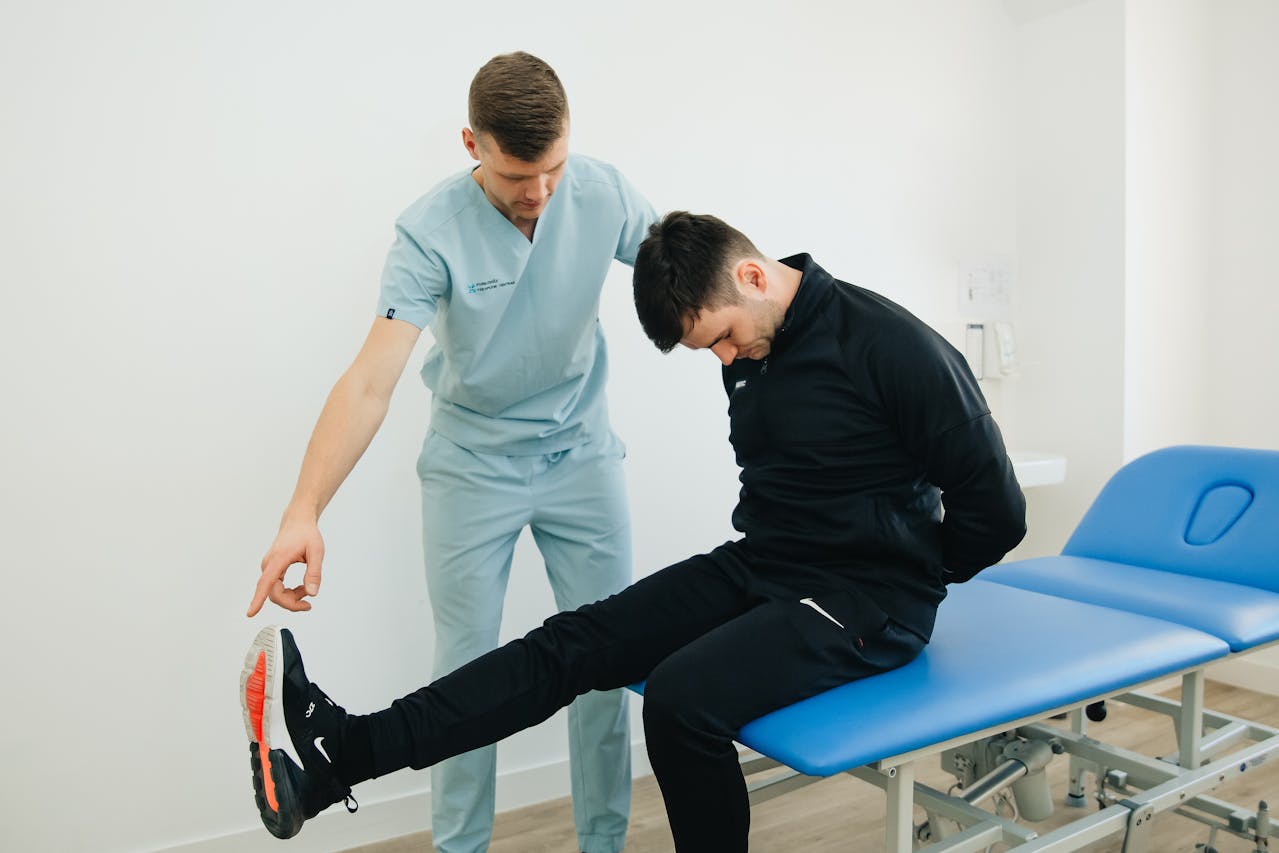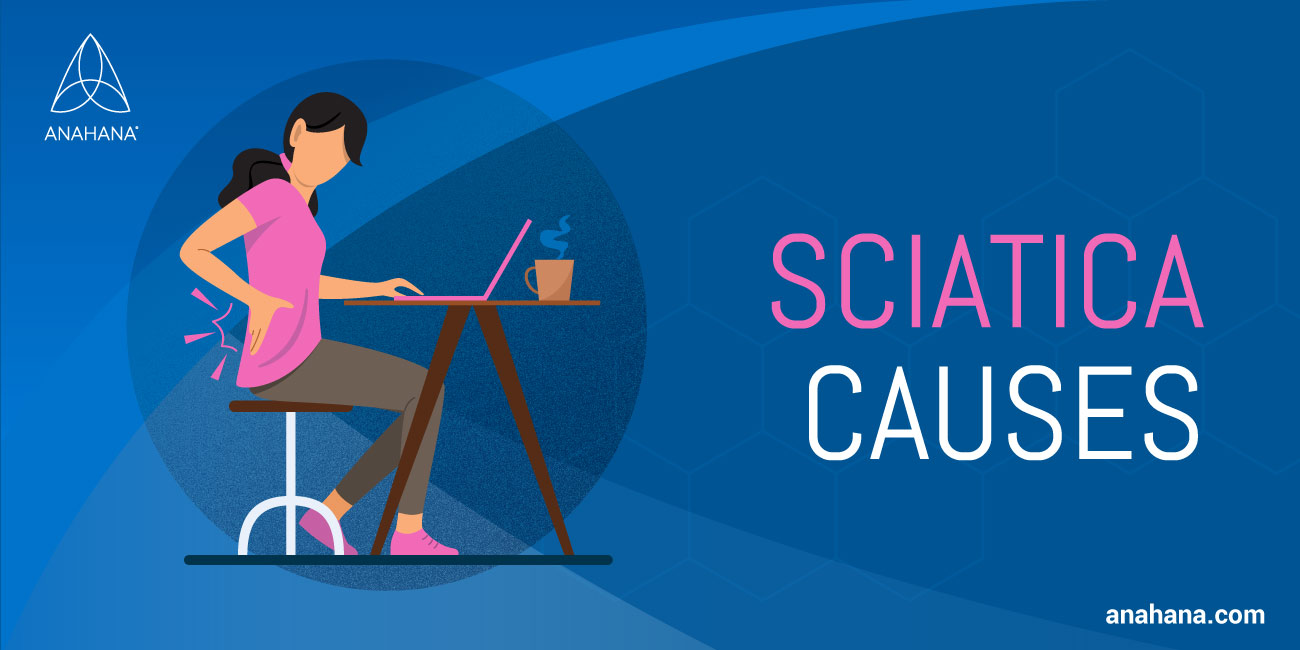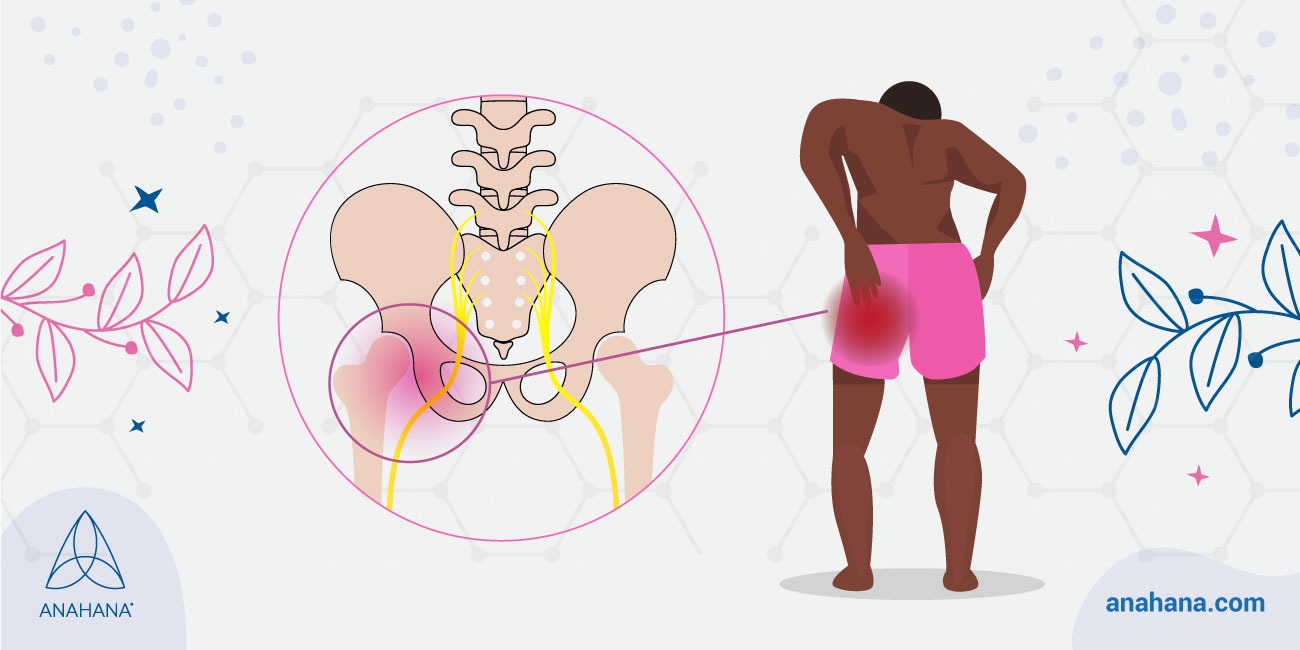7
What is Sciatica
Last Updated: November 4, 2024

Table of Contents
Sciatica is when the sciatic nerve, the longest and widest single nerve in the body, becomes irritated or compressed. The pinched nerve can cause pain that radiates from your lower back down to your foot.
Key Takeaways
- Definition: Sciatica occurs when the sciatic nerve, the body's longest and widest nerve, becomes irritated or compressed, causing pain from the lower back to the foot.
- Symptoms: Common symptoms include radiating pain, tingling, burning, numbness, weakness in the affected leg, and loss of bowel or bladder control.
- Risk Factors: Include age, obesity, occupation, prolonged sitting, and diabetes.
- Causes: Often caused by herniated discs, spinal stenosis, spondylolisthesis, back or spine pain, or piriformis syndrome.
- Treatment: Includes physical therapy, lifestyle changes, medications, steroid injections, and in severe cases, surgery.
What is Sciatica?
As many as 40% of the global population suffers from sciatica at some point in their lifetime. In addition, the third most common reason people visit their healthcare provider is back pain. As the largest nerve in the human body, many things can cause the condition, including injury, poor posture, hip problems, herniated discs, and bone spurs.
What are the symptoms of sciatica?
Sciatica is a complex condition that has various intense and painful symptoms. Some of the most common symptoms of sciatica include:
- Pain radiating from the lower back and down one leg
- A tingling, burning or numbing sensation in the affected area
- Weakness or difficulty moving the leg or foot
- Difficulty sitting for long periods
- Knee and leg pain down the affected leg
How is sciatica diagnosed?
To diagnose sciatica, your doctor will ask for your complete medical history before asking about your symptoms. They may then do a physical exam to check for muscle weakness, loss of limb sensation, and reflexes. During the exam, they might test your range of motion and strength by asking you to perform specific movements such as walking on your toes or heels, rising from a squatting position, and lifting your legs one at a time while lying on your back. Pain from sciatica will usually worsen with these types of movements.
Your doctor may also order imaging tests to look for nerve damage or problems in the spine, such as an X-ray or MRI. In some cases, they may request a nerve conduction study to measure how well the sciatic nerve functions. This test involves sending small electrical impulses through the nerves to check their response.
Once they have identified the underlying cause of your sciatica, they can recommend treatment options such as physical therapy, lifestyle changes, medications, or surgery. With the right treatment plan, you can experience relief from sciatica and its symptoms.
What causes sciatica?
 Sciatica typically occurs from pressure on the nerve, which runs from your lower back and down both legs. Common causes of sciatica include a herniated disc, lumbar spinal stenosis, spondylolisthesis, and piriformis syndrome. If you are experiencing pain radiating through your sciatic nerve, you must see a healthcare provider immediately. They can determine the cause of your pain and recommend treatment options such as physical therapy, medications, or in severe cases, referral to orthopedic surgeons. It is important to note that certain people are more likely to develop sciatica, including those who sit for long periods.
Sciatica typically occurs from pressure on the nerve, which runs from your lower back and down both legs. Common causes of sciatica include a herniated disc, lumbar spinal stenosis, spondylolisthesis, and piriformis syndrome. If you are experiencing pain radiating through your sciatic nerve, you must see a healthcare provider immediately. They can determine the cause of your pain and recommend treatment options such as physical therapy, medications, or in severe cases, referral to orthopedic surgeons. It is important to note that certain people are more likely to develop sciatica, including those who sit for long periods.
How does sciatic nerve pain feel?
Sciatica pain can vary from person to person, ranging from a mild tingling sensation to a sharp, burning pain that radiates down the leg. It is often described as an electric shock-like feeling when the sciatic nerve becomes compressed or irritated. The shooting pain may be localized in one area or spread out into the buttocks and down the back of the leg. Some people also experience numbness or weakness in the affected area. It is important to note that sciatica pain can worsen from prolonged sitting, standing, or bending over. It is also common for the pain to get worse when coughing or sneezing.
Where is the sciatica pressure point?
Two specific pressure points can be used to relieve sciatica pain. The first is just behind the big toe, and the second is under the foot's ball. You can use a lacrosse or tennis ball to release these points. Place the ball under your foot and roll it around until you find a tender spot. Once you find a tender spot, apply pressure and hold for 30-60 seconds. This can help relieve the severe pain in your sciatic nerve and other sciatica symptoms.
Can sciatica cause knee pain?
 Yes, sciatica can cause knee pain. Sciatic nerve pain and other related symptoms can extend down to the lower leg and make a pit stop in your knee via a sciatic nerve branch. This nerve is known as the peroneal nerve and, when affected, can lead to a dull ache, warm sensation, or sharp pain anywhere around the knee. If you are experiencing sciatica with accompanying knee pain, it is essential to seek medical advice, as this may be a sign of a more serious underlying condition.
Yes, sciatica can cause knee pain. Sciatic nerve pain and other related symptoms can extend down to the lower leg and make a pit stop in your knee via a sciatic nerve branch. This nerve is known as the peroneal nerve and, when affected, can lead to a dull ache, warm sensation, or sharp pain anywhere around the knee. If you are experiencing sciatica with accompanying knee pain, it is essential to seek medical advice, as this may be a sign of a more serious underlying condition.
Who to see for sciatica?
If you are experiencing sciatica, seeing a healthcare professional as soon as possible is essential. The two most common types of healthcare providers who typically treat sciatica and other nerve issues are chiropractors and osteopaths. Both can provide spinal manipulation and manual therapies to help alleviate pain and heal the underlying condition. Your doctor may also recommend other treatments such as physical therapy, lifestyle changes, medications, or surgery. It is essential to find the right treatment plan for you to experience relief from sciatica and its symptoms.
How sciatica relates to other conditions
Are sciatica and shingles related?
Yes, sciatica and shingles can be related. Viral infections such as shingles can mimic spine pain conditions and result in sciatica pain symptoms. If the pain precedes the onset of a severe, painful rash over one area of the lower back or down the leg on one side, it could be related to shingles. In this case, it is vital to seek help from a healthcare professional as soon as possible so they can accurately diagnose the condition and recommend appropriate treatment options.
Are sciatica and lumbar radiculopathy the same?
No, sciatica and lumbar radiculopathy are not the same. Radiculopathy is a condition that occurs when compressed nerve roots or nerves in the spinal cord develop due to injury or disease. This can cause pain, numbness, and weakness along the path of the affected nerve root.
Sciatica is a symptom of this condition and typically involves pain that radiates through the sciatic nerve, which runs from the lower back down to the foot. Radiculopathy is treated with medications, physical therapy, or in more severe cases, surgery. If you are experiencing symptoms of radiculopathy or sciatica pain, seek immediate medical attention to determine an accurate diagnosis and appropriate treatment plan.
Are sciatica and herniated disk related?
 Yes, sciatica and herniated disks are related. A herniated disk occurs when the material inside the spinal disk forces through a tear in its outer layer, which puts pressure on the sciatic nerve and causes pain. Depending on the location of the herniated disc, it can cause symptoms anywhere along the path of the affected nerve. If you are experiencing any type of sciatica-like pain, a herniated disc should be ruled out as a possible cause by seeing a healthcare professional.
Yes, sciatica and herniated disks are related. A herniated disk occurs when the material inside the spinal disk forces through a tear in its outer layer, which puts pressure on the sciatic nerve and causes pain. Depending on the location of the herniated disc, it can cause symptoms anywhere along the path of the affected nerve. If you are experiencing any type of sciatica-like pain, a herniated disc should be ruled out as a possible cause by seeing a healthcare professional.
Are sciatica and piriformis syndrome the same?
No, sciatica and piriformis syndrome are not the same. Piriformis syndrome is a condition in which the piriformis muscle becomes inflamed or tight, which can result in compression of the sciatic nerve and cause pain. Common symptoms usually include an ache or burning sensation radiating down the leg and numbness and tingling in the affected area. Piriformis syndrome can be treated with physical therapy, stretching, strengthening exercises, medications, or injections. If you are experiencing sciatica pain, it is essential to tell your doctor so they can determine whether or not a possible cause could be piriformis syndrome.
Are sciatica and spondylolisthesis the same?
No, sciatica and spondylolisthesis are not the same. Spondylolisthesis is a condition in which one vertebra slides out of place over another, causing compression of the spinal nerves and resulting in pain. Sciatica is a symptom of this condition and can involve pain radiating through sciatic nerves, which run from the lower back to the foot. If you are experiencing symptoms of spondylolisthesis, seek help from a healthcare professional so they can correctly diagnose the condition and recommend appropriate treatment options.
Can sciatica cause Cauda Equina Syndrome?
Sciatica can sometimes lead to a rare but severe condition called Cauda Equina Syndrome. This occurs when a herniated disc or other cause compresses the nerves that travel from the spinal cord to the lower back, ultimately affecting bowel or bladder function. Symptoms of this condition include leg weakness, loss of sensation in the buttocks and legs, bladder dysfunction, and loss of bowel control. It is essential to seek medical attention immediately if experiencing any of these symptoms.
Treatment for Cauda Equina Syndrome typically involves decompression surgery to relieve the pressure on the nerves. In some cases, people will need further intervention by seeing a physical therapist, taking strong medication such as muscle relaxants or anti-inflammatories, and making lifestyle changes.
How to relieve sciatica pain
Although sciatica can be painful, there are ways to relieve its symptoms. Most people with sciatica feel better after self-care measures or at-home remedies like using cold and heat packs. Cold packs can be applied to the painful area for up to 20 minutes several times a day. After 2-3 days, hot packs can also provide additional relief. Avoid bedrest, and try your best to stay active. Stretching exercises and practicing proper posture can help loosen muscles and ease tension in the lower spine. Your doctor may also recommend medications to help reduce sciatica pain.
How is sciatica treated?
In most cases, sciatica can be resolved with time and conservative, non-surgical treatments. However, your doctor may recommend surgery if the pain persists despite these treatments. It is essential to talk to your healthcare provider about the best course of action for you. The goal is always to reduce pain, restore mobility and prevent future sciatica flare-ups. With the right treatment plan, it is possible to manage and even cure sciatica in some cases.
Maintaining a healthy lifestyle with regular exercise, good posture, stress management, and proper nutrition is vital for optimal health. Regular checkups are essential for catching any problems early before they become serious. With the right approach, finding lasting relief from sciatica is possible.
The takeaway
 Sciatica is a common condition that can cause intense pain and discomfort. Fortunately, there are several treatments available to relieve the symptoms of sciatica, including stretching, cold/hot packs, medications, and in some cases, surgery. Talking to your healthcare provider about the best treatment plan for you is essential. With the right approach, it is possible to manage and even cure sciatica in some cases.
Sciatica is a common condition that can cause intense pain and discomfort. Fortunately, there are several treatments available to relieve the symptoms of sciatica, including stretching, cold/hot packs, medications, and in some cases, surgery. Talking to your healthcare provider about the best treatment plan for you is essential. With the right approach, it is possible to manage and even cure sciatica in some cases.
Remember that a healthy lifestyle with regular exercise, good posture, stress management, and proper nutrition is essential for optimal health – so don’t forget to take care of yourself! With the right treatment plan, you can find lasting relief from sciatica.
References
Mayo Clinic Q and A: Sciatica Treatment Options.
Sciatica - Diagnosis and treatment - Mayo Clinic
Sciatica Treatment - How To Diagnose & Treat Sciatica - AICA Orthopedics.
What We Know About Sciatica Knee Pain
Disclaimer
The contents of this article are provided for informational purposes only and are not intended to substitute for professional medical advice, diagnosis, or treatment. It is always recommended to consult with a qualified healthcare provider before making any health-related changes or if you have any questions or concerns about your health. Anahana is not liable for any errors, omissions, or consequences that may occur from using the information provided.

Dr. Darlene Buan-Basit is a highly experienced licensed Chiropractor and Pilates instructor with expertise in many techniques, including Medical Acupuncture, Traditional Chinese Medicine, and Advanced Massage Techniques.